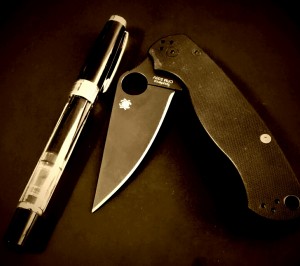Certain Things, by A.M.
Posted by admin on Sep 24th 2014

There are certain things in this world that I consider things of beauty. A Porsche. A fountain pen. And a knife. I love the lines and the design. I love the craftsmanship and the thought that went into it. Take out a well made folding knife and flick it open. Schlick! Did you hear that? The sound of it locking into place. Maybe it’s a compression lock. Or a framelock. Or a liner lock. If the knife is built right, once it’s locked up, there’s no way it’s moving. It’s ready to do whatever cutting job you throw at it until YOU decide it’s time to unlock it and fold it back in.
But after a while, the knife dulls. Then what? You could send it back to the company and pay them to sharpen it, if they offer that service. But then you’re without your favorite and most needed tool for who knows how long. You could give it to a pro to sharpen if there’s one in your area. Or, you could learn to sharpen it yourself.
At first I thought I was a sharpening failure. I spend hours and hours watching YouTube freehand sharpening videos. I bought whetstones. I tried to maintain my angle, even though I never was too sure what it was to begin with, let alone how to replicate it over and over, and on both sides. I destroyed pages of copy paper and phone book paper testing for sharpness. All for naught.
And then out of desperation, I ordered the Spyderco Sharpmaker. I watched Sal’s video. He looked nice enough. The instructions seemed pretty easy. No guesswork on angles. Looked pretty foolproof. And sure enough, it was! Mostly. Because it’s slightly more complicated than Sal makes his own product look. If you want a blade that’s pretty sharp, then what he says to do is fine. But if you want a blade that slices through phonebook paper like it’s not even there, you need to do more. Not as easy as twenty strokes per side and call it a day. Because you need to listen. Really listen to the sound the knife is making as you slide it down the sides of the ceramic triangles. I find that when the knife is sharp, really sharp, it stops making any sound at all. It just glides down the sides of the ceramic. Whispers. Sometimes it’s so close! I think it’s done, just to hear one wrong sound at one spot on the blade. Then it’s time to give that one spot some special treatment until it becomes one with the rest of the blade. Then it’s time to do some more work on the other side of the blade to ensure that there’s no burr waiting to ruin your day. (I’m not sure I’ve ever actually had a burr on any of my knives, but I know it can be there, and I know I don’t want one.) And of course for that samurai-sharp edge, you have to buy the ultra fine stones too. No getting around that one.
Then the strop. That’s the tricky part. I don’t want to press too hard and round my edge. So just a few light back and forth strokes, hoping to keep the angle right. (Alas, there’s no Sharpmaker strop stones, although Sal might want to consider that someday.)
And then the big test. Rip out a sheet of phonebook paper and slice the knife through it. Listen to that! Swoosh! Like the paper is jumping out of the way of the knife. It knows how sharp that knife is. It knows how much time you spent on it.
And that’s it. Fold it up and stick it back in your pocket. You knife is now sharp, and all is right with the world again.

